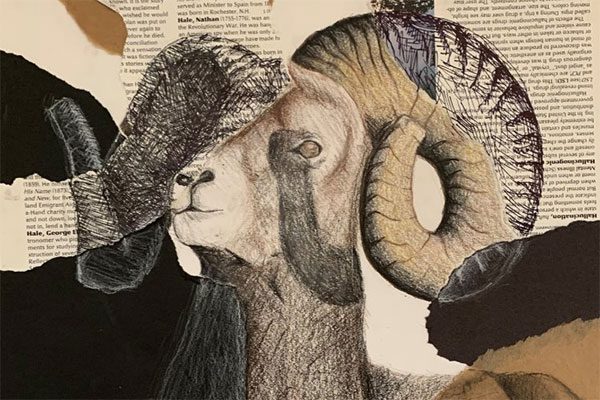
February 3 – April 7, 2022
The 1 Million – Multiple Species Eradication explores bio-/multi-species extinctions and the species affected by humanity’s mass resource extraction.
Inspired by this National Geographic article, artist Carol Rashawnna Williams created the large scale monoprint installation with seven contributing local/national visual artists:
- Amaranta Ibarra-Sandys
- Paula Oliver
- Noa Piper
- Sydney Pertl
- Kelly and Hope Bain
- Rosalind Davis Guterson
“We are NO longer talking about animal extinction but entire species eradication, in which the tipping point of resource extraction symptoms, causes and old-world paradigms will either make or break human civilization.”
Carol Rashawnna Williams
While working in relative physical isolation for two years, the seven artists have worked to be in constant contact, learning, growing and exploring these topics together through their various art forms. The shared experiences, fears, hopes, dreams, visions and commitments to Mother Earth of the collective galvanized them to create this work. The effects of the COVID-19 pandemic, the killings of African Americans by police and BIPOC housing displacement and insecurities also shaped the exhibition and artists work.
The collective also uncovered new research and awareness of resource extraction, climate change, and sustainable infrastructures. The 1 Million – Multiple Species Eradication seeks to connect our beliefs, ancestral knowledge and the impact humans have on mass extinctions. Resources to learn more are collected here.
About the Organizing Artist
Carol Rashawnna Williams is a Seattle-based, interdisciplinary artist who makes work that engages audiences in conversations about social, environmental and racial justice.
Throughout her practice, Williams contends that the only way to shift race relations and understand climate change is through collective imaginings and re-imaginings of equitable relationships to the land, animals and resources. Williams’ aesthetic forms fall, swim, fly, drip and grow through various layers of reality, spirituality and data analysis. Her narrative installations reject the tidy, toxic logic of scarcity models, suggesting powerful alternatives in collective storytelling, collective ownership, collective re-valuing of biospecies and collective commitments to sustainable environmental practices over time.
Williams earned the ArtsWa Public Artist Roster (2021), International Masters Book World Wide Art Books (2021), Artists to Know World Wide Books (2021), Rachels Network Catalyst Finalist Award (2020) and the Cornish Fine Art College, Neddy Finalist Award (2020), The Office of Arts and Culture Artist Up Mentorly Scholarship (2021), Residency in Berlin, Germany (2021) and the 4Culture Conductive Garboil Award (2018), an Artist Residency AADK Spain (2018), a 4Culture Artist Community Grant Award (2017) and was accepted to Seattle Office of Arts & Culture’s Public Art Boot Camp (2018).
She is the owner of K-Love 4 Art, co-founder of both Race & Climate Justice Art Collective and ARTifACTS, and the Co-Executive Director at Community Arts Create. She was accepted into both the Environmental Leadership Program, a yearlong national fellowship to support emerging leaders in environmental justice, Interweave, Sustainable Seattle’s (S2) support, mentorship and fiscal sponsor for the BIPOC Sustainable Tiny Art House Community Campaign.
Also on view
Three additional installations will also be on view in the gallery: A Clearer View: The Last Days of the Alaskan Way Viaduct by Roxann Murray and Eirik Johnson; Home of Good: A Black Seattle Storyquilt by Storme Webber; and Diversity by Design by AIA Seattle’s Diversity Roundtable.
A Clearer View: The Last Days of the Alaskan Way Viaduct features 11 photographs by Roxann Murray and Eirik Johnson that documented the monumental transformation of Downtown Seattle’s waterfront as the Alaskan Way Viaduct was torn down. The Seattle Office of the Waterfront and Civic Projects and the Seattle Office of Arts & Culture commissioned photographers Murray and Johnson to document the last days and demolition from the 2019 Goodbye Viaduct celebration to the removal of the final sections, each artist spent months documenting the last days of the iconic elevated roadway that divided the city.
Murray’s work captures the transformation of the Central Waterfront through the people and communities shaped by the highway, while Johnson memorializes the last views and the perspectives that went away with the roadway. Together, Murray and Johnson captured over 100 images of the monumental transformation to Downtown Seattle and the people who lived and worked in the area. The photographs featured in the exhibition were purchased using Seattle Department of Transportation 1% for Art funds (generated by the waterfront and seawall projects) and will be added to the city’s Civic Collection. Additional photographs can be viewed here.
Visit ARTS at King Street Station
ARTS at King Street Station is FREE and open to the public:
Tuesday through Saturday, 10am – 6pm
10am – 8pm on First Thursdays
Please visit us on the top of King Street Station at 303 S Jackson Street, Seattle, WA 98104.
COVID Safety
In accordance with King County’s vaccination verification guidance, people ages 12 and older will be required to show proof of full COVID-19 vaccination or a negative test result to enter. Masks are required, regardless of vaccination status.
The 1 Million – Multiple Species Eradication is organized and presented by the Seattle Office of Arts & Culture in partnership with program lead Jenny Ku and the ARTS at King Street Station Advisors. Support for the installation is provided by Benjamin Gale-Schreck and Blake Haygood.






